Financial Management Report: CBA Performance Analysis (2018-2019)
VerifiedAdded on 2023/01/07
|18
|4171
|37
Report
AI Summary
This report presents a comprehensive financial analysis of the Commonwealth Bank of Australia (CBA), examining its financial performance from 2018 to 2019. The analysis includes an overview of the bank's background and business, followed by an examination of its financial statements and current economic outlook. The core of the report focuses on a detailed ratio analysis, covering profitability ratios (e.g., return on assets, net profit margin), efficiency ratios (e.g., asset turnover, cash return on assets), liquidity ratios (e.g., current ratio, quick ratio), and gearing ratios. Each ratio is calculated, presented, and discussed, comparing the bank's performance to industry averages. The report concludes with recommendations and an overall assessment of CBA's financial health, supported by calculations in the appendices. The report fulfills the requirements of a FINA600 Financial Management assignment.
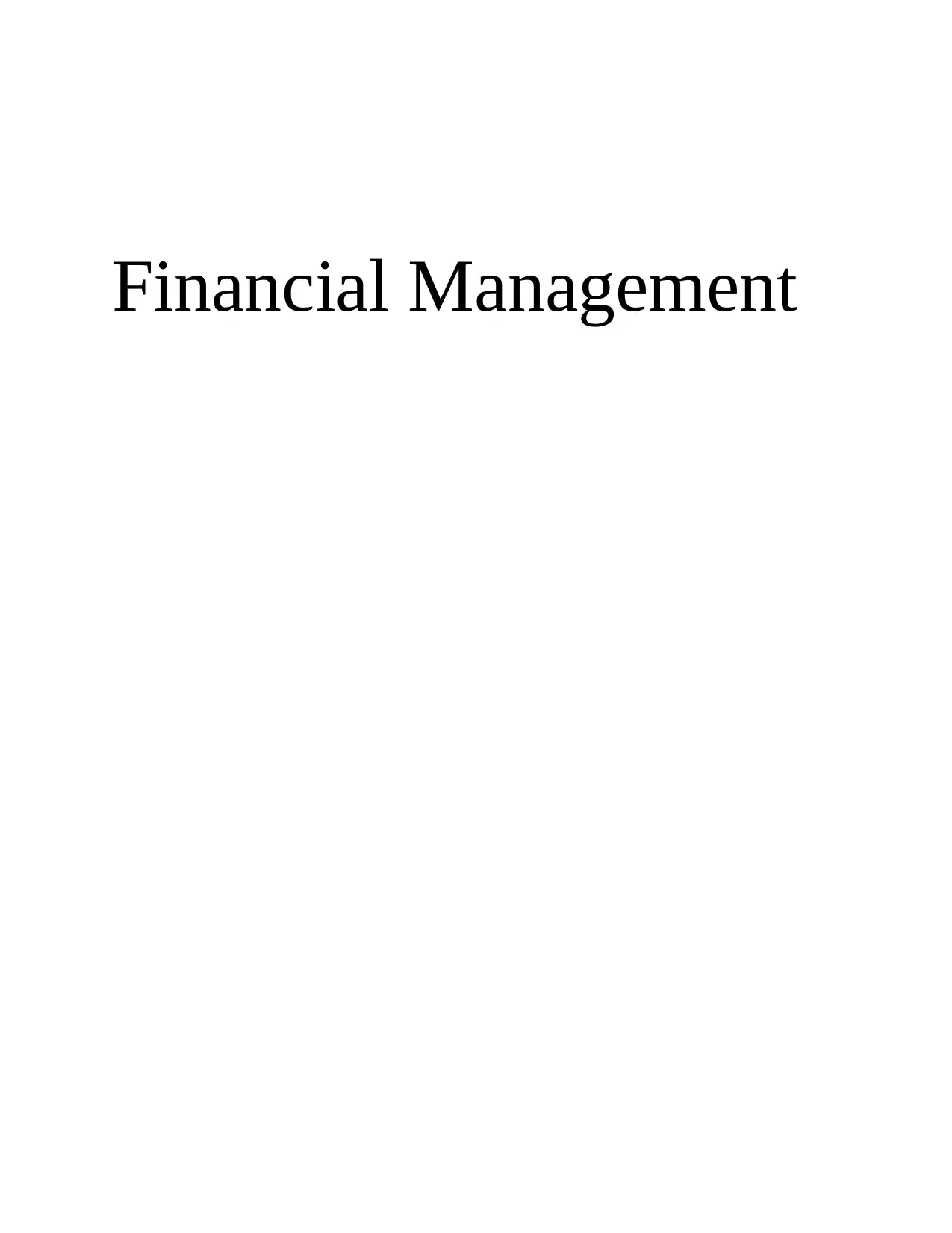
Financial Management
Paraphrase This Document
Need a fresh take? Get an instant paraphrase of this document with our AI Paraphraser
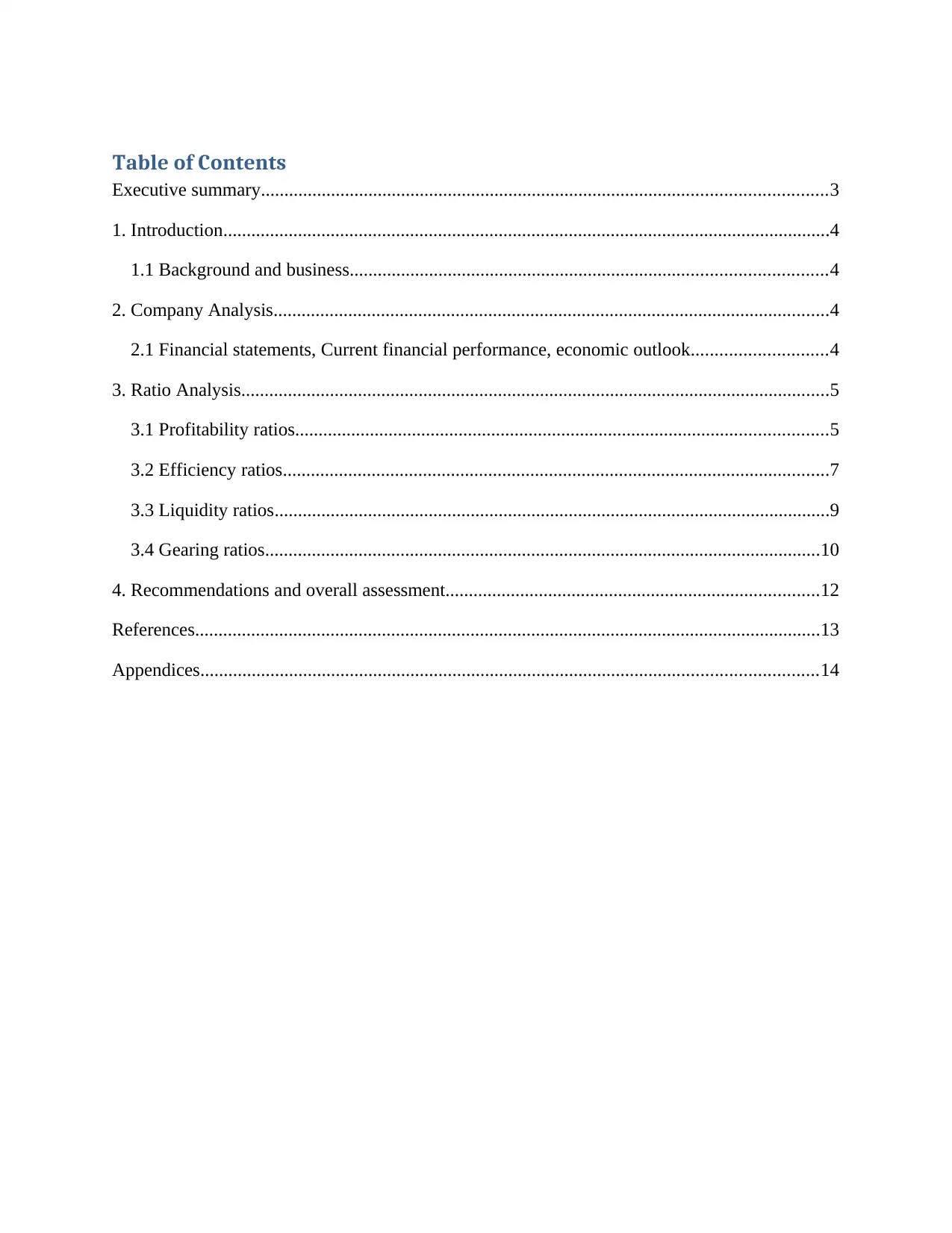
Table of Contents
Executive summary.........................................................................................................................3
1. Introduction..................................................................................................................................4
1.1 Background and business......................................................................................................4
2. Company Analysis.......................................................................................................................4
2.1 Financial statements, Current financial performance, economic outlook.............................4
3. Ratio Analysis..............................................................................................................................5
3.1 Profitability ratios..................................................................................................................5
3.2 Efficiency ratios.....................................................................................................................7
3.3 Liquidity ratios.......................................................................................................................9
3.4 Gearing ratios.......................................................................................................................10
4. Recommendations and overall assessment................................................................................12
References......................................................................................................................................13
Appendices....................................................................................................................................14
Executive summary.........................................................................................................................3
1. Introduction..................................................................................................................................4
1.1 Background and business......................................................................................................4
2. Company Analysis.......................................................................................................................4
2.1 Financial statements, Current financial performance, economic outlook.............................4
3. Ratio Analysis..............................................................................................................................5
3.1 Profitability ratios..................................................................................................................5
3.2 Efficiency ratios.....................................................................................................................7
3.3 Liquidity ratios.......................................................................................................................9
3.4 Gearing ratios.......................................................................................................................10
4. Recommendations and overall assessment................................................................................12
References......................................................................................................................................13
Appendices....................................................................................................................................14
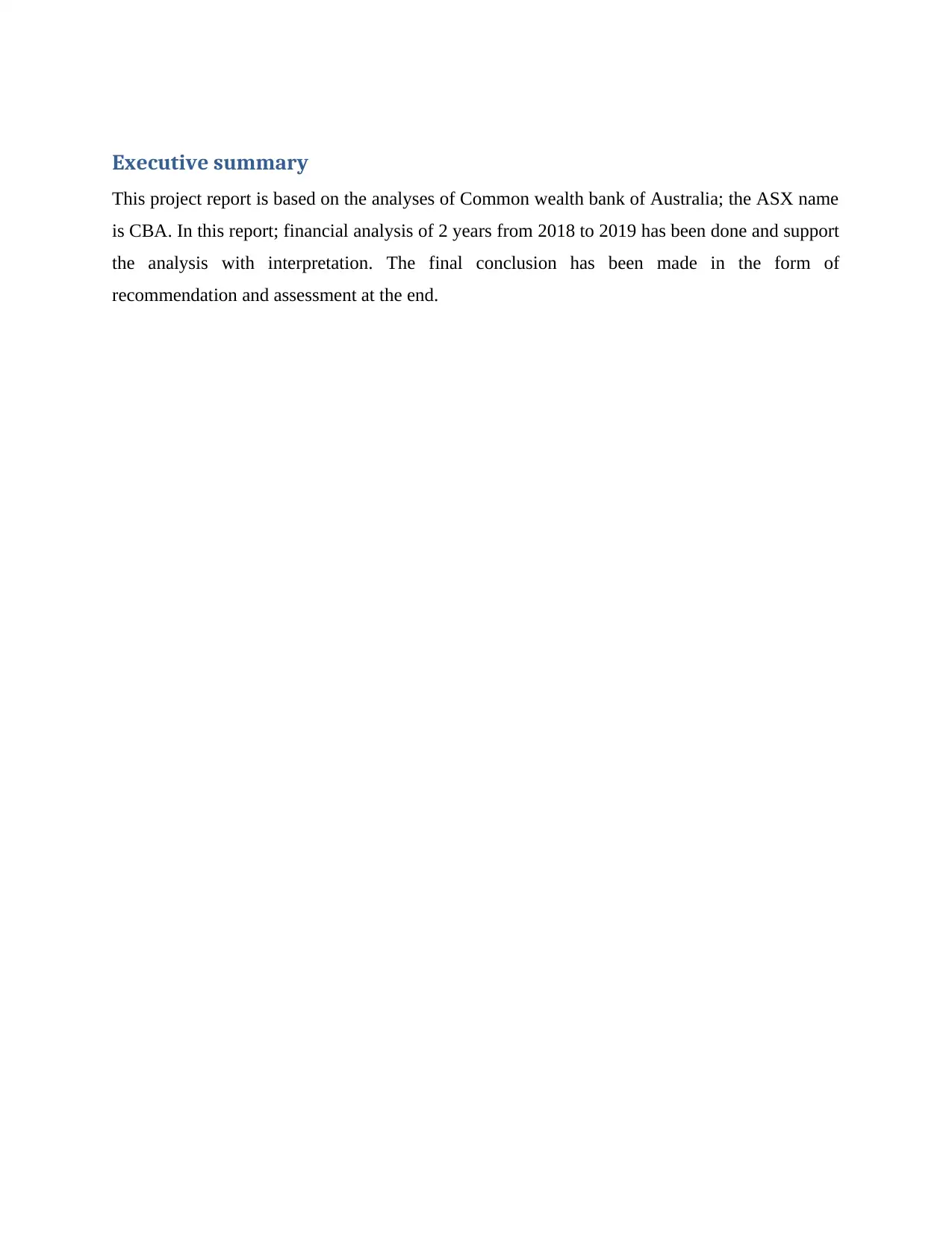
Executive summary
This project report is based on the analyses of Common wealth bank of Australia; the ASX name
is CBA. In this report; financial analysis of 2 years from 2018 to 2019 has been done and support
the analysis with interpretation. The final conclusion has been made in the form of
recommendation and assessment at the end.
This project report is based on the analyses of Common wealth bank of Australia; the ASX name
is CBA. In this report; financial analysis of 2 years from 2018 to 2019 has been done and support
the analysis with interpretation. The final conclusion has been made in the form of
recommendation and assessment at the end.
⊘ This is a preview!⊘
Do you want full access?
Subscribe today to unlock all pages.

Trusted by 1+ million students worldwide
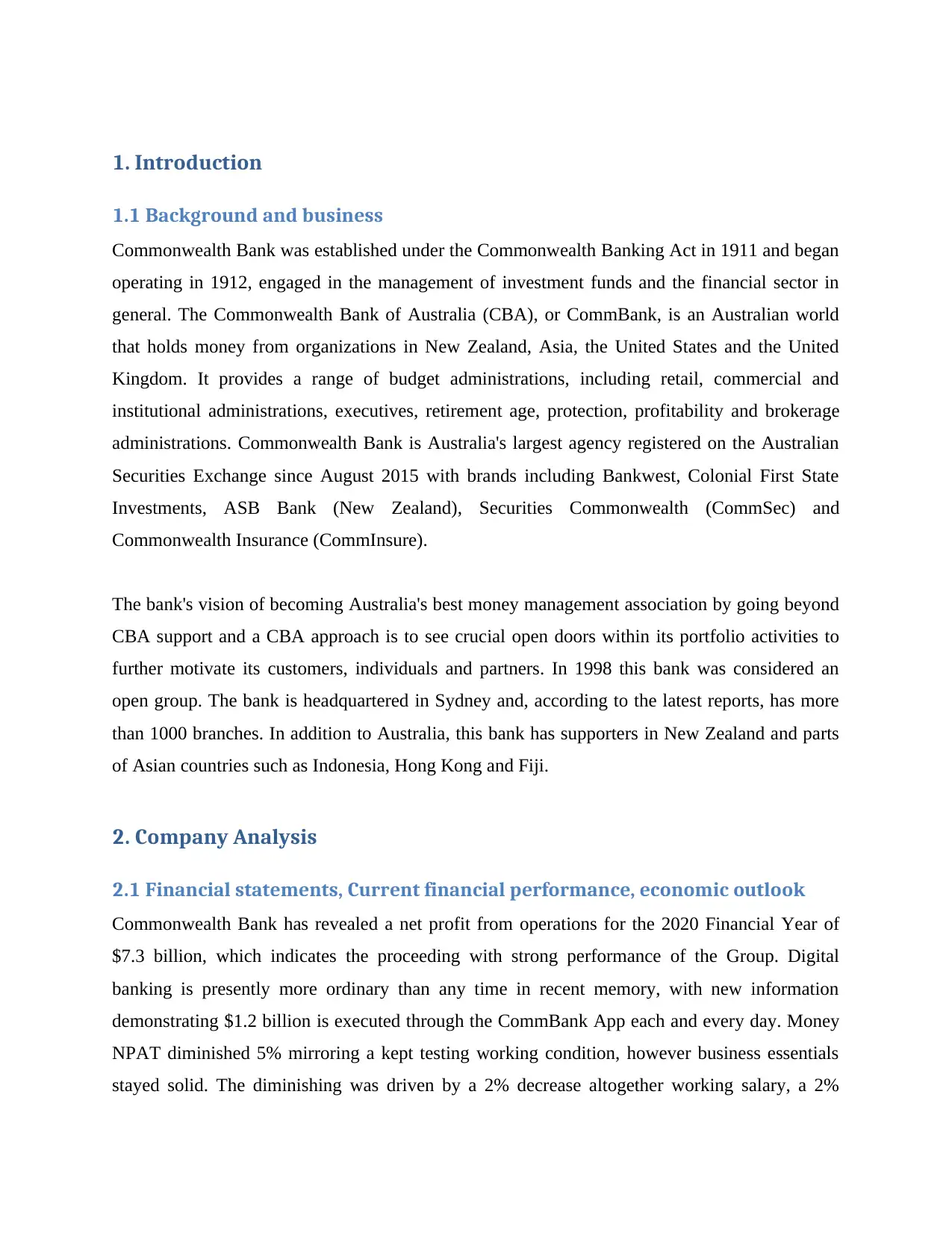
1. Introduction
1.1 Background and business
Commonwealth Bank was established under the Commonwealth Banking Act in 1911 and began
operating in 1912, engaged in the management of investment funds and the financial sector in
general. The Commonwealth Bank of Australia (CBA), or CommBank, is an Australian world
that holds money from organizations in New Zealand, Asia, the United States and the United
Kingdom. It provides a range of budget administrations, including retail, commercial and
institutional administrations, executives, retirement age, protection, profitability and brokerage
administrations. Commonwealth Bank is Australia's largest agency registered on the Australian
Securities Exchange since August 2015 with brands including Bankwest, Colonial First State
Investments, ASB Bank (New Zealand), Securities Commonwealth (CommSec) and
Commonwealth Insurance (CommInsure).
The bank's vision of becoming Australia's best money management association by going beyond
CBA support and a CBA approach is to see crucial open doors within its portfolio activities to
further motivate its customers, individuals and partners. In 1998 this bank was considered an
open group. The bank is headquartered in Sydney and, according to the latest reports, has more
than 1000 branches. In addition to Australia, this bank has supporters in New Zealand and parts
of Asian countries such as Indonesia, Hong Kong and Fiji.
2. Company Analysis
2.1 Financial statements, Current financial performance, economic outlook
Commonwealth Bank has revealed a net profit from operations for the 2020 Financial Year of
$7.3 billion, which indicates the proceeding with strong performance of the Group. Digital
banking is presently more ordinary than any time in recent memory, with new information
demonstrating $1.2 billion is executed through the CommBank App each and every day. Money
NPAT diminished 5% mirroring a kept testing working condition, however business essentials
stayed solid. The diminishing was driven by a 2% decrease altogether working salary, a 2%
1.1 Background and business
Commonwealth Bank was established under the Commonwealth Banking Act in 1911 and began
operating in 1912, engaged in the management of investment funds and the financial sector in
general. The Commonwealth Bank of Australia (CBA), or CommBank, is an Australian world
that holds money from organizations in New Zealand, Asia, the United States and the United
Kingdom. It provides a range of budget administrations, including retail, commercial and
institutional administrations, executives, retirement age, protection, profitability and brokerage
administrations. Commonwealth Bank is Australia's largest agency registered on the Australian
Securities Exchange since August 2015 with brands including Bankwest, Colonial First State
Investments, ASB Bank (New Zealand), Securities Commonwealth (CommSec) and
Commonwealth Insurance (CommInsure).
The bank's vision of becoming Australia's best money management association by going beyond
CBA support and a CBA approach is to see crucial open doors within its portfolio activities to
further motivate its customers, individuals and partners. In 1998 this bank was considered an
open group. The bank is headquartered in Sydney and, according to the latest reports, has more
than 1000 branches. In addition to Australia, this bank has supporters in New Zealand and parts
of Asian countries such as Indonesia, Hong Kong and Fiji.
2. Company Analysis
2.1 Financial statements, Current financial performance, economic outlook
Commonwealth Bank has revealed a net profit from operations for the 2020 Financial Year of
$7.3 billion, which indicates the proceeding with strong performance of the Group. Digital
banking is presently more ordinary than any time in recent memory, with new information
demonstrating $1.2 billion is executed through the CommBank App each and every day. Money
NPAT diminished 5% mirroring a kept testing working condition, however business essentials
stayed solid. The diminishing was driven by a 2% decrease altogether working salary, a 2%
Paraphrase This Document
Need a fresh take? Get an instant paraphrase of this document with our AI Paraphraser
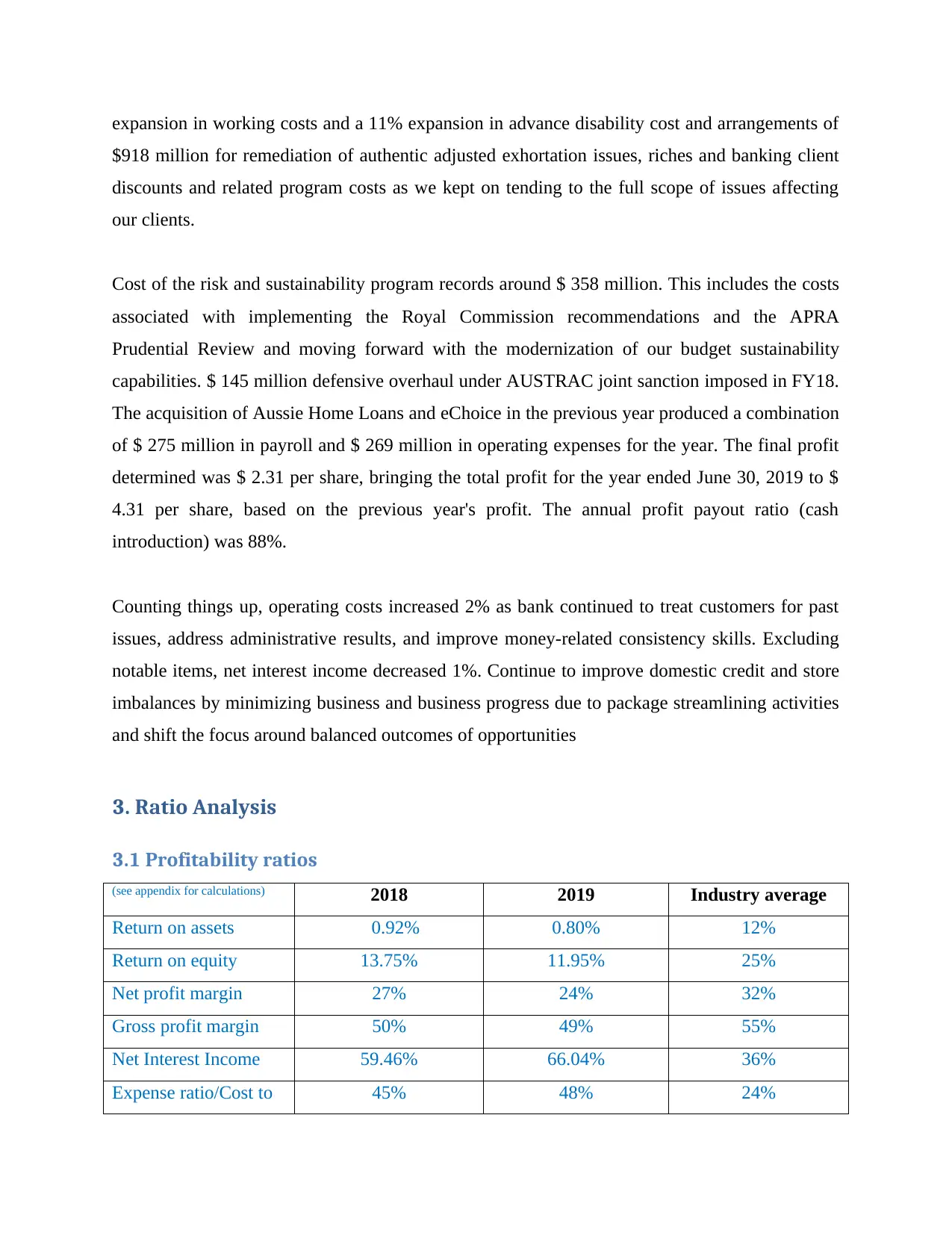
expansion in working costs and a 11% expansion in advance disability cost and arrangements of
$918 million for remediation of authentic adjusted exhortation issues, riches and banking client
discounts and related program costs as we kept on tending to the full scope of issues affecting
our clients.
Cost of the risk and sustainability program records around $ 358 million. This includes the costs
associated with implementing the Royal Commission recommendations and the APRA
Prudential Review and moving forward with the modernization of our budget sustainability
capabilities. $ 145 million defensive overhaul under AUSTRAC joint sanction imposed in FY18.
The acquisition of Aussie Home Loans and eChoice in the previous year produced a combination
of $ 275 million in payroll and $ 269 million in operating expenses for the year. The final profit
determined was $ 2.31 per share, bringing the total profit for the year ended June 30, 2019 to $
4.31 per share, based on the previous year's profit. The annual profit payout ratio (cash
introduction) was 88%.
Counting things up, operating costs increased 2% as bank continued to treat customers for past
issues, address administrative results, and improve money-related consistency skills. Excluding
notable items, net interest income decreased 1%. Continue to improve domestic credit and store
imbalances by minimizing business and business progress due to package streamlining activities
and shift the focus around balanced outcomes of opportunities
3. Ratio Analysis
3.1 Profitability ratios
(see appendix for calculations) 2018 2019 Industry average
Return on assets 0.92% 0.80% 12%
Return on equity 13.75% 11.95% 25%
Net profit margin 27% 24% 32%
Gross profit margin 50% 49% 55%
Net Interest Income 59.46% 66.04% 36%
Expense ratio/Cost to 45% 48% 24%
$918 million for remediation of authentic adjusted exhortation issues, riches and banking client
discounts and related program costs as we kept on tending to the full scope of issues affecting
our clients.
Cost of the risk and sustainability program records around $ 358 million. This includes the costs
associated with implementing the Royal Commission recommendations and the APRA
Prudential Review and moving forward with the modernization of our budget sustainability
capabilities. $ 145 million defensive overhaul under AUSTRAC joint sanction imposed in FY18.
The acquisition of Aussie Home Loans and eChoice in the previous year produced a combination
of $ 275 million in payroll and $ 269 million in operating expenses for the year. The final profit
determined was $ 2.31 per share, bringing the total profit for the year ended June 30, 2019 to $
4.31 per share, based on the previous year's profit. The annual profit payout ratio (cash
introduction) was 88%.
Counting things up, operating costs increased 2% as bank continued to treat customers for past
issues, address administrative results, and improve money-related consistency skills. Excluding
notable items, net interest income decreased 1%. Continue to improve domestic credit and store
imbalances by minimizing business and business progress due to package streamlining activities
and shift the focus around balanced outcomes of opportunities
3. Ratio Analysis
3.1 Profitability ratios
(see appendix for calculations) 2018 2019 Industry average
Return on assets 0.92% 0.80% 12%
Return on equity 13.75% 11.95% 25%
Net profit margin 27% 24% 32%
Gross profit margin 50% 49% 55%
Net Interest Income 59.46% 66.04% 36%
Expense ratio/Cost to 45% 48% 24%
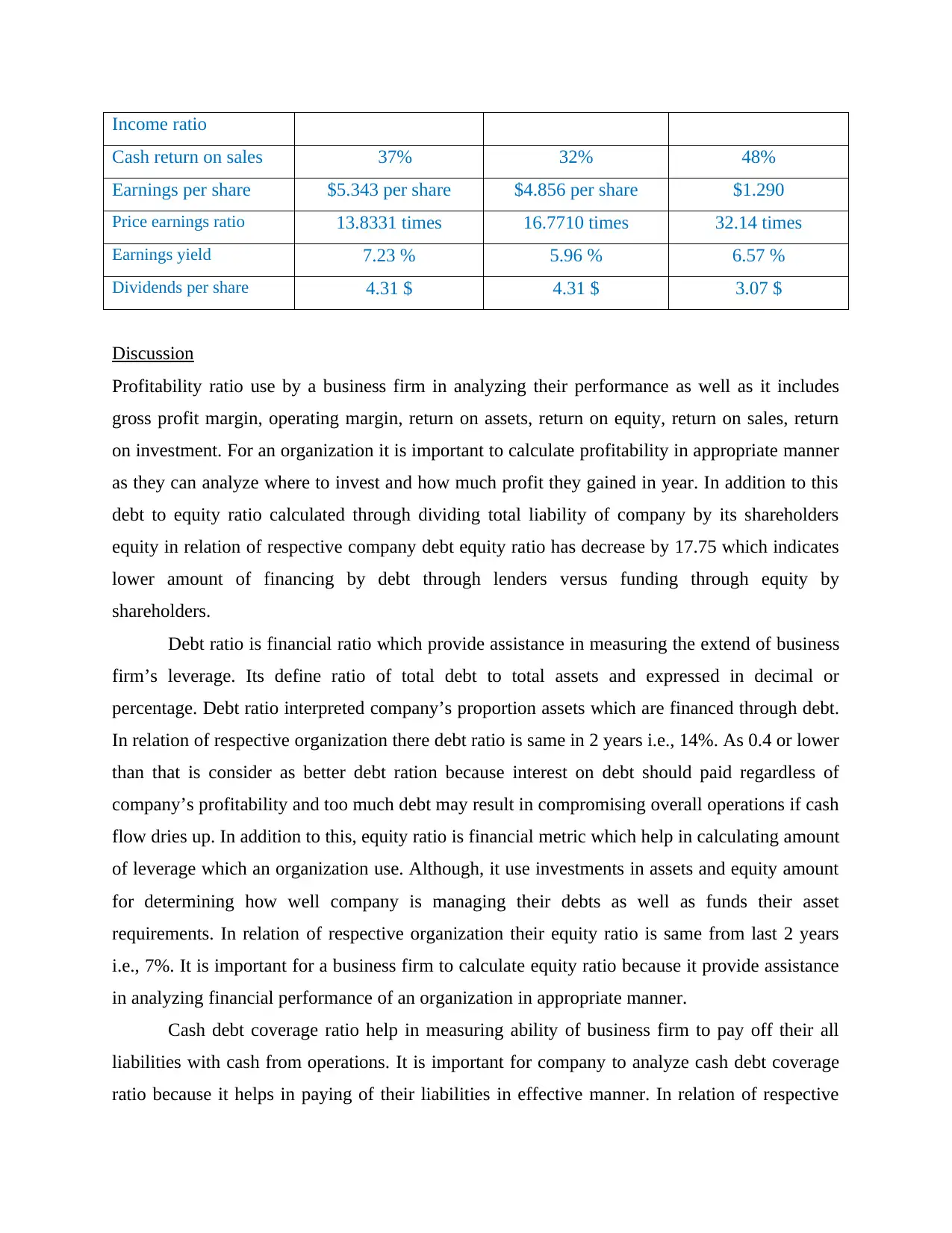
Income ratio
Cash return on sales 37% 32% 48%
Earnings per share $5.343 per share $4.856 per share $1.290
Price earnings ratio 13.8331 times 16.7710 times 32.14 times
Earnings yield 7.23 % 5.96 % 6.57 %
Dividends per share 4.31 $ 4.31 $ 3.07 $
Discussion
Profitability ratio use by a business firm in analyzing their performance as well as it includes
gross profit margin, operating margin, return on assets, return on equity, return on sales, return
on investment. For an organization it is important to calculate profitability in appropriate manner
as they can analyze where to invest and how much profit they gained in year. In addition to this
debt to equity ratio calculated through dividing total liability of company by its shareholders
equity in relation of respective company debt equity ratio has decrease by 17.75 which indicates
lower amount of financing by debt through lenders versus funding through equity by
shareholders.
Debt ratio is financial ratio which provide assistance in measuring the extend of business
firm’s leverage. Its define ratio of total debt to total assets and expressed in decimal or
percentage. Debt ratio interpreted company’s proportion assets which are financed through debt.
In relation of respective organization there debt ratio is same in 2 years i.e., 14%. As 0.4 or lower
than that is consider as better debt ration because interest on debt should paid regardless of
company’s profitability and too much debt may result in compromising overall operations if cash
flow dries up. In addition to this, equity ratio is financial metric which help in calculating amount
of leverage which an organization use. Although, it use investments in assets and equity amount
for determining how well company is managing their debts as well as funds their asset
requirements. In relation of respective organization their equity ratio is same from last 2 years
i.e., 7%. It is important for a business firm to calculate equity ratio because it provide assistance
in analyzing financial performance of an organization in appropriate manner.
Cash debt coverage ratio help in measuring ability of business firm to pay off their all
liabilities with cash from operations. It is important for company to analyze cash debt coverage
ratio because it helps in paying of their liabilities in effective manner. In relation of respective
Cash return on sales 37% 32% 48%
Earnings per share $5.343 per share $4.856 per share $1.290
Price earnings ratio 13.8331 times 16.7710 times 32.14 times
Earnings yield 7.23 % 5.96 % 6.57 %
Dividends per share 4.31 $ 4.31 $ 3.07 $
Discussion
Profitability ratio use by a business firm in analyzing their performance as well as it includes
gross profit margin, operating margin, return on assets, return on equity, return on sales, return
on investment. For an organization it is important to calculate profitability in appropriate manner
as they can analyze where to invest and how much profit they gained in year. In addition to this
debt to equity ratio calculated through dividing total liability of company by its shareholders
equity in relation of respective company debt equity ratio has decrease by 17.75 which indicates
lower amount of financing by debt through lenders versus funding through equity by
shareholders.
Debt ratio is financial ratio which provide assistance in measuring the extend of business
firm’s leverage. Its define ratio of total debt to total assets and expressed in decimal or
percentage. Debt ratio interpreted company’s proportion assets which are financed through debt.
In relation of respective organization there debt ratio is same in 2 years i.e., 14%. As 0.4 or lower
than that is consider as better debt ration because interest on debt should paid regardless of
company’s profitability and too much debt may result in compromising overall operations if cash
flow dries up. In addition to this, equity ratio is financial metric which help in calculating amount
of leverage which an organization use. Although, it use investments in assets and equity amount
for determining how well company is managing their debts as well as funds their asset
requirements. In relation of respective organization their equity ratio is same from last 2 years
i.e., 7%. It is important for a business firm to calculate equity ratio because it provide assistance
in analyzing financial performance of an organization in appropriate manner.
Cash debt coverage ratio help in measuring ability of business firm to pay off their all
liabilities with cash from operations. It is important for company to analyze cash debt coverage
ratio because it helps in paying of their liabilities in effective manner. In relation of respective
⊘ This is a preview!⊘
Do you want full access?
Subscribe today to unlock all pages.

Trusted by 1+ million students worldwide
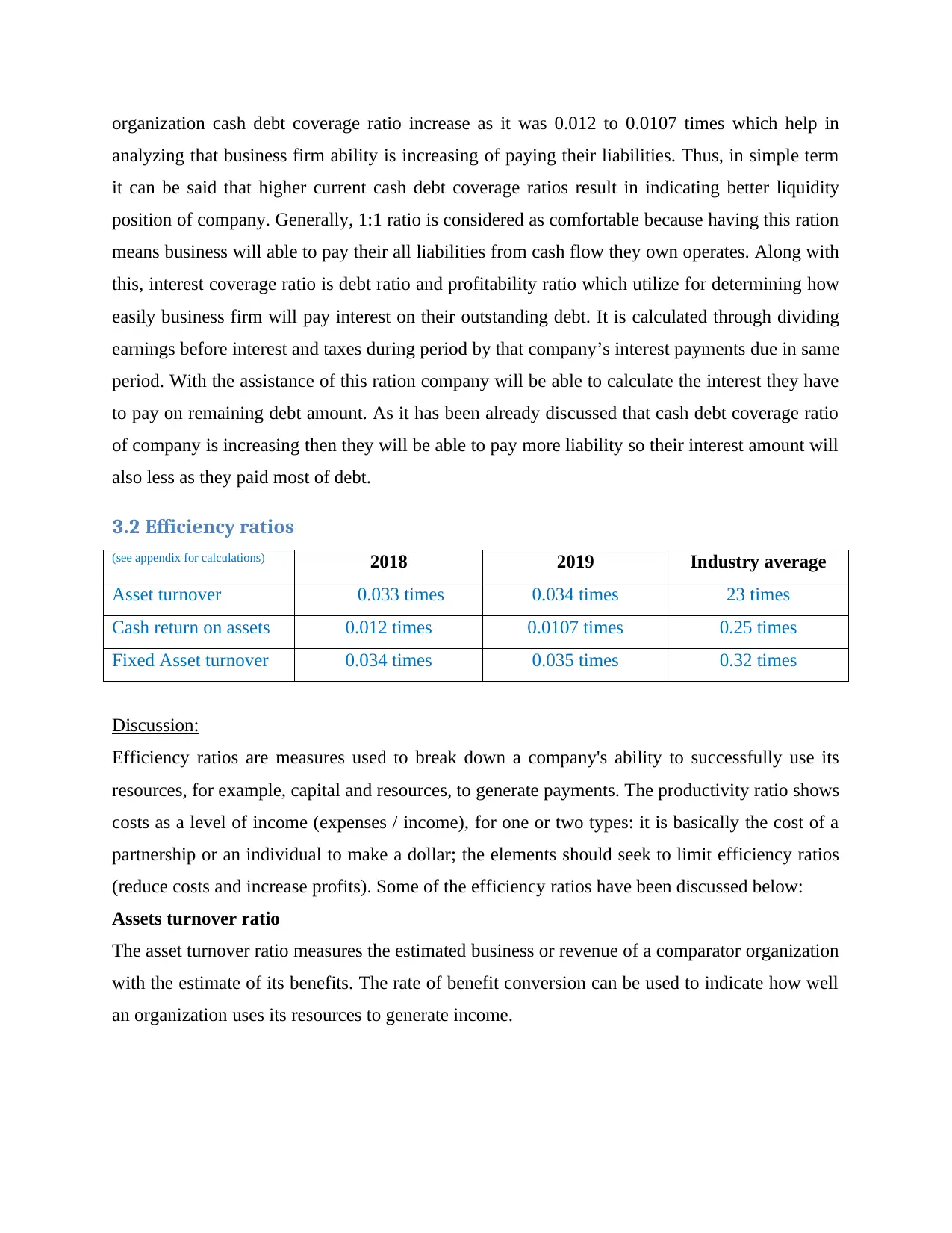
organization cash debt coverage ratio increase as it was 0.012 to 0.0107 times which help in
analyzing that business firm ability is increasing of paying their liabilities. Thus, in simple term
it can be said that higher current cash debt coverage ratios result in indicating better liquidity
position of company. Generally, 1:1 ratio is considered as comfortable because having this ration
means business will able to pay their all liabilities from cash flow they own operates. Along with
this, interest coverage ratio is debt ratio and profitability ratio which utilize for determining how
easily business firm will pay interest on their outstanding debt. It is calculated through dividing
earnings before interest and taxes during period by that company’s interest payments due in same
period. With the assistance of this ration company will be able to calculate the interest they have
to pay on remaining debt amount. As it has been already discussed that cash debt coverage ratio
of company is increasing then they will be able to pay more liability so their interest amount will
also less as they paid most of debt.
3.2 Efficiency ratios
(see appendix for calculations) 2018 2019 Industry average
Asset turnover 0.033 times 0.034 times 23 times
Cash return on assets 0.012 times 0.0107 times 0.25 times
Fixed Asset turnover 0.034 times 0.035 times 0.32 times
Discussion:
Efficiency ratios are measures used to break down a company's ability to successfully use its
resources, for example, capital and resources, to generate payments. The productivity ratio shows
costs as a level of income (expenses / income), for one or two types: it is basically the cost of a
partnership or an individual to make a dollar; the elements should seek to limit efficiency ratios
(reduce costs and increase profits). Some of the efficiency ratios have been discussed below:
Assets turnover ratio
The asset turnover ratio measures the estimated business or revenue of a comparator organization
with the estimate of its benefits. The rate of benefit conversion can be used to indicate how well
an organization uses its resources to generate income.
analyzing that business firm ability is increasing of paying their liabilities. Thus, in simple term
it can be said that higher current cash debt coverage ratios result in indicating better liquidity
position of company. Generally, 1:1 ratio is considered as comfortable because having this ration
means business will able to pay their all liabilities from cash flow they own operates. Along with
this, interest coverage ratio is debt ratio and profitability ratio which utilize for determining how
easily business firm will pay interest on their outstanding debt. It is calculated through dividing
earnings before interest and taxes during period by that company’s interest payments due in same
period. With the assistance of this ration company will be able to calculate the interest they have
to pay on remaining debt amount. As it has been already discussed that cash debt coverage ratio
of company is increasing then they will be able to pay more liability so their interest amount will
also less as they paid most of debt.
3.2 Efficiency ratios
(see appendix for calculations) 2018 2019 Industry average
Asset turnover 0.033 times 0.034 times 23 times
Cash return on assets 0.012 times 0.0107 times 0.25 times
Fixed Asset turnover 0.034 times 0.035 times 0.32 times
Discussion:
Efficiency ratios are measures used to break down a company's ability to successfully use its
resources, for example, capital and resources, to generate payments. The productivity ratio shows
costs as a level of income (expenses / income), for one or two types: it is basically the cost of a
partnership or an individual to make a dollar; the elements should seek to limit efficiency ratios
(reduce costs and increase profits). Some of the efficiency ratios have been discussed below:
Assets turnover ratio
The asset turnover ratio measures the estimated business or revenue of a comparator organization
with the estimate of its benefits. The rate of benefit conversion can be used to indicate how well
an organization uses its resources to generate income.
Paraphrase This Document
Need a fresh take? Get an instant paraphrase of this document with our AI Paraphraser
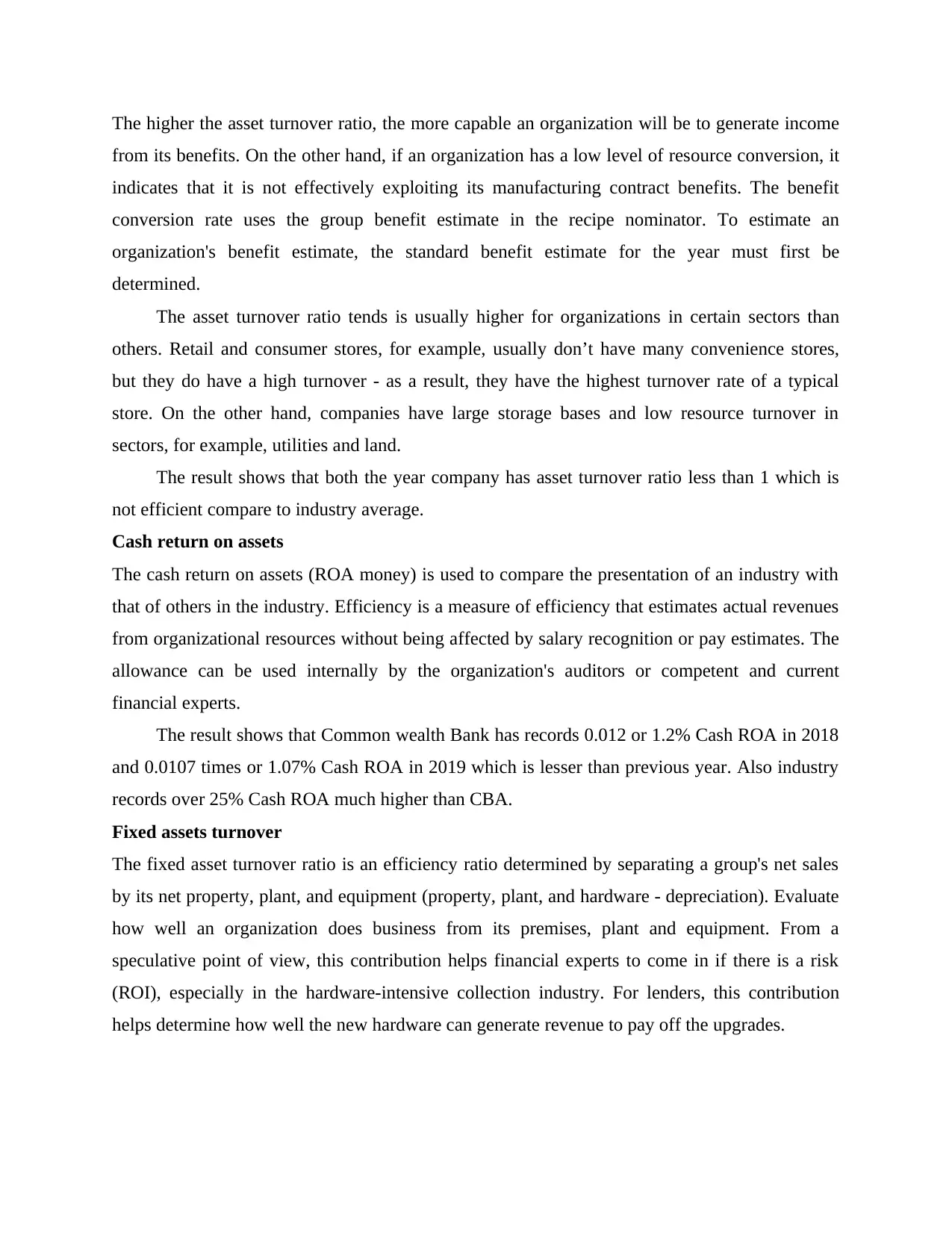
The higher the asset turnover ratio, the more capable an organization will be to generate income
from its benefits. On the other hand, if an organization has a low level of resource conversion, it
indicates that it is not effectively exploiting its manufacturing contract benefits. The benefit
conversion rate uses the group benefit estimate in the recipe nominator. To estimate an
organization's benefit estimate, the standard benefit estimate for the year must first be
determined.
The asset turnover ratio tends is usually higher for organizations in certain sectors than
others. Retail and consumer stores, for example, usually don’t have many convenience stores,
but they do have a high turnover - as a result, they have the highest turnover rate of a typical
store. On the other hand, companies have large storage bases and low resource turnover in
sectors, for example, utilities and land.
The result shows that both the year company has asset turnover ratio less than 1 which is
not efficient compare to industry average.
Cash return on assets
The cash return on assets (ROA money) is used to compare the presentation of an industry with
that of others in the industry. Efficiency is a measure of efficiency that estimates actual revenues
from organizational resources without being affected by salary recognition or pay estimates. The
allowance can be used internally by the organization's auditors or competent and current
financial experts.
The result shows that Common wealth Bank has records 0.012 or 1.2% Cash ROA in 2018
and 0.0107 times or 1.07% Cash ROA in 2019 which is lesser than previous year. Also industry
records over 25% Cash ROA much higher than CBA.
Fixed assets turnover
The fixed asset turnover ratio is an efficiency ratio determined by separating a group's net sales
by its net property, plant, and equipment (property, plant, and hardware - depreciation). Evaluate
how well an organization does business from its premises, plant and equipment. From a
speculative point of view, this contribution helps financial experts to come in if there is a risk
(ROI), especially in the hardware-intensive collection industry. For lenders, this contribution
helps determine how well the new hardware can generate revenue to pay off the upgrades.
from its benefits. On the other hand, if an organization has a low level of resource conversion, it
indicates that it is not effectively exploiting its manufacturing contract benefits. The benefit
conversion rate uses the group benefit estimate in the recipe nominator. To estimate an
organization's benefit estimate, the standard benefit estimate for the year must first be
determined.
The asset turnover ratio tends is usually higher for organizations in certain sectors than
others. Retail and consumer stores, for example, usually don’t have many convenience stores,
but they do have a high turnover - as a result, they have the highest turnover rate of a typical
store. On the other hand, companies have large storage bases and low resource turnover in
sectors, for example, utilities and land.
The result shows that both the year company has asset turnover ratio less than 1 which is
not efficient compare to industry average.
Cash return on assets
The cash return on assets (ROA money) is used to compare the presentation of an industry with
that of others in the industry. Efficiency is a measure of efficiency that estimates actual revenues
from organizational resources without being affected by salary recognition or pay estimates. The
allowance can be used internally by the organization's auditors or competent and current
financial experts.
The result shows that Common wealth Bank has records 0.012 or 1.2% Cash ROA in 2018
and 0.0107 times or 1.07% Cash ROA in 2019 which is lesser than previous year. Also industry
records over 25% Cash ROA much higher than CBA.
Fixed assets turnover
The fixed asset turnover ratio is an efficiency ratio determined by separating a group's net sales
by its net property, plant, and equipment (property, plant, and hardware - depreciation). Evaluate
how well an organization does business from its premises, plant and equipment. From a
speculative point of view, this contribution helps financial experts to come in if there is a risk
(ROI), especially in the hardware-intensive collection industry. For lenders, this contribution
helps determine how well the new hardware can generate revenue to pay off the upgrades.

A consistently fixed asset turnover ratio indicates that a company is using its profits
appropriately and productively to generate revenue. The low turnover rate of fixed assets for the
most part shows the opposite: a company does not use its profits successfully or to the maximum
extent of its revenue generating potential. Allowances alone do not guarantee the success of an
organization’s use of its established resources. Combined with several tests, it can distance you
from activities, performance, and benefits advice.
Thus, the result shows that in 2018; company records 3.4% and 3.5% Fixed assets turnover
ratio in 2019. This indicates, CBA has efficiently utilizes its resources in 2019, but not as much
efficiently as industry does.
3.3 Liquidity ratios
(see appendix for calculations) YYYY YYYY Industry average
Current ratio 3.31:1 2.97:1 1.25:1
Quick ratio 3.31:1 2.97:1 0.87:1
Receivables turnover Days Days 78 Days
Average collection period Days Days 219Days
Discussion
This is a ratio which shows capability of company to pay off its debt in given period of time
without become insolvent. Therefore, one can say that this indicates the speed with which an
organization can convert its current resources into cash with the aim of being able to fulfill its
liability on a timely basis. For the most part, liquidity and momentary dissolvability are used
together. The amount of liquidity affects the creditworthiness of the group as much as the credit
rating of the company. This proportion therefore plays an important role in the monetary
difficulties associated with any group funds and credit rating. Some of the liquidity ratios have
been discussed below:
Current ratio
A current ratio is a liquidity ratio that measures the ability of an organization to meet interim or
reasonable commitments within one year. It shows finance experts and experts how an
appropriately and productively to generate revenue. The low turnover rate of fixed assets for the
most part shows the opposite: a company does not use its profits successfully or to the maximum
extent of its revenue generating potential. Allowances alone do not guarantee the success of an
organization’s use of its established resources. Combined with several tests, it can distance you
from activities, performance, and benefits advice.
Thus, the result shows that in 2018; company records 3.4% and 3.5% Fixed assets turnover
ratio in 2019. This indicates, CBA has efficiently utilizes its resources in 2019, but not as much
efficiently as industry does.
3.3 Liquidity ratios
(see appendix for calculations) YYYY YYYY Industry average
Current ratio 3.31:1 2.97:1 1.25:1
Quick ratio 3.31:1 2.97:1 0.87:1
Receivables turnover Days Days 78 Days
Average collection period Days Days 219Days
Discussion
This is a ratio which shows capability of company to pay off its debt in given period of time
without become insolvent. Therefore, one can say that this indicates the speed with which an
organization can convert its current resources into cash with the aim of being able to fulfill its
liability on a timely basis. For the most part, liquidity and momentary dissolvability are used
together. The amount of liquidity affects the creditworthiness of the group as much as the credit
rating of the company. This proportion therefore plays an important role in the monetary
difficulties associated with any group funds and credit rating. Some of the liquidity ratios have
been discussed below:
Current ratio
A current ratio is a liquidity ratio that measures the ability of an organization to meet interim or
reasonable commitments within one year. It shows finance experts and experts how an
⊘ This is a preview!⊘
Do you want full access?
Subscribe today to unlock all pages.

Trusted by 1+ million students worldwide

organization can expand the existing resources of its asset relationship to meet its current
responsibilities and various debts.
Both the year have current ratio more than ideal one which is 2:1; which indicates
inefficiency of bank to utilize its short-term cash in proper way.
Quick ratio
The quick ratio is an indicator of an organization’s short-term liquidity position and measures an
organization’s ability to deliver on its immediate commitments with its most mobile assets.
Because it demonstrates the ability of the organization to use its close funds (resources that can
be quickly converted into cash) in half to pay off its current liabilities, the ratio is called analysis
with it as well.
Quick Proportion demonstrates an organization’s ability to meet its current liabilities
without the intention of selling their stock or obtaining additional funding. The snappy ratio is
seen as a more traditional measure than the conventional ratio, which includes all conventional
assets as an inclusion for current liabilities. The higher the ration yield, the better the liquidity
and well-being associated with money; the lower the proportion, the more likely it is that the
organization will find it difficult to meet its obligations.
Banks only provides services due to which there are no inventories with bank and hence
quick ratio also shows same result.
Due to non-availability of credit sales of Common wealth bank; receivables turnover has
not been calculated.
3.4 Gearing ratios
(see appendix for calculations) YYYY YYYY Industry average
Debt to equity ratio 219% 201% 154%
Debt ratio 14% 13.55% 9.86%
Equity ratio 6.58% 6.73% 15%
Cash debt coverage 1.33% 1.15% 7.2%
Interest cover ratio 0.73 times 0.59 times 4.56 Times
responsibilities and various debts.
Both the year have current ratio more than ideal one which is 2:1; which indicates
inefficiency of bank to utilize its short-term cash in proper way.
Quick ratio
The quick ratio is an indicator of an organization’s short-term liquidity position and measures an
organization’s ability to deliver on its immediate commitments with its most mobile assets.
Because it demonstrates the ability of the organization to use its close funds (resources that can
be quickly converted into cash) in half to pay off its current liabilities, the ratio is called analysis
with it as well.
Quick Proportion demonstrates an organization’s ability to meet its current liabilities
without the intention of selling their stock or obtaining additional funding. The snappy ratio is
seen as a more traditional measure than the conventional ratio, which includes all conventional
assets as an inclusion for current liabilities. The higher the ration yield, the better the liquidity
and well-being associated with money; the lower the proportion, the more likely it is that the
organization will find it difficult to meet its obligations.
Banks only provides services due to which there are no inventories with bank and hence
quick ratio also shows same result.
Due to non-availability of credit sales of Common wealth bank; receivables turnover has
not been calculated.
3.4 Gearing ratios
(see appendix for calculations) YYYY YYYY Industry average
Debt to equity ratio 219% 201% 154%
Debt ratio 14% 13.55% 9.86%
Equity ratio 6.58% 6.73% 15%
Cash debt coverage 1.33% 1.15% 7.2%
Interest cover ratio 0.73 times 0.59 times 4.56 Times
Paraphrase This Document
Need a fresh take? Get an instant paraphrase of this document with our AI Paraphraser

Discussion
A gearing ratio is a general classification that represents a financial ratio that looks at the type of
owner value (or cash flow) for the resources acquired by the organization. Equipment is an
estimate of the impact on an organization's budget, and the breakdown of clothing is one of the
best-known strategies for assessing an organization's financial well-being. Despite the presence
of a few types, the best-known proportion measures how much an organization is backed by a
liability relative to the amount financed by the value, which is consistently referred to as the
closed-valuation of assets. A high equipment ratio means that the organization has a higher level
of responsibility than value. On the other hand, a low equipment ratio means that the
organization has some responsibility with respect to value. Some of the types of gearing ratios
have been discussed below with the results from calculation:
Debt to equity ratio
This ratio shows the proportion of debt compares to equity, there’s no good or bad ratio but more
ratio shows lower weighted average cost of capital and more risk of become insolvent. Common
wealth bank has shown ratio of above 2:1 in both years; but the risk is manageable by bank due
to its regular income in the form of interest incomes and investments.
Debt ratio
The debt ratio is a financial ratio that measures the rate of reduction of a company's finances. The
debt ratio is defined as the ratio of total debt to total assets, expressed as a decimal or percentage.
It can be defined as the proportion of a company's assets that are financed by debt. The result
shows debt ratio in 2018 is 14% and in 2019 it decreased to 13.55% and hence this indicates that
bank has enough assets to pay off its long term liability.
Equity ratio
The result shows equity ratio in 2018 is 6.58% while in 2019 it records 6.73%; a higher ratio
shows good financial strength of an organization and solvency of company. Therefore, 2019;
banks solvency is better than 2018.
Cash debt coverage
The cash debt coverage ratio, or cash-to-debt ratio, examines the relationship between a
company's operating cash flow and its total liabilities and determines their actual potential
business to repay its debts from its operations. The ideal ratio is 1:1 and result shows cash debt
A gearing ratio is a general classification that represents a financial ratio that looks at the type of
owner value (or cash flow) for the resources acquired by the organization. Equipment is an
estimate of the impact on an organization's budget, and the breakdown of clothing is one of the
best-known strategies for assessing an organization's financial well-being. Despite the presence
of a few types, the best-known proportion measures how much an organization is backed by a
liability relative to the amount financed by the value, which is consistently referred to as the
closed-valuation of assets. A high equipment ratio means that the organization has a higher level
of responsibility than value. On the other hand, a low equipment ratio means that the
organization has some responsibility with respect to value. Some of the types of gearing ratios
have been discussed below with the results from calculation:
Debt to equity ratio
This ratio shows the proportion of debt compares to equity, there’s no good or bad ratio but more
ratio shows lower weighted average cost of capital and more risk of become insolvent. Common
wealth bank has shown ratio of above 2:1 in both years; but the risk is manageable by bank due
to its regular income in the form of interest incomes and investments.
Debt ratio
The debt ratio is a financial ratio that measures the rate of reduction of a company's finances. The
debt ratio is defined as the ratio of total debt to total assets, expressed as a decimal or percentage.
It can be defined as the proportion of a company's assets that are financed by debt. The result
shows debt ratio in 2018 is 14% and in 2019 it decreased to 13.55% and hence this indicates that
bank has enough assets to pay off its long term liability.
Equity ratio
The result shows equity ratio in 2018 is 6.58% while in 2019 it records 6.73%; a higher ratio
shows good financial strength of an organization and solvency of company. Therefore, 2019;
banks solvency is better than 2018.
Cash debt coverage
The cash debt coverage ratio, or cash-to-debt ratio, examines the relationship between a
company's operating cash flow and its total liabilities and determines their actual potential
business to repay its debts from its operations. The ideal ratio is 1:1 and result shows cash debt
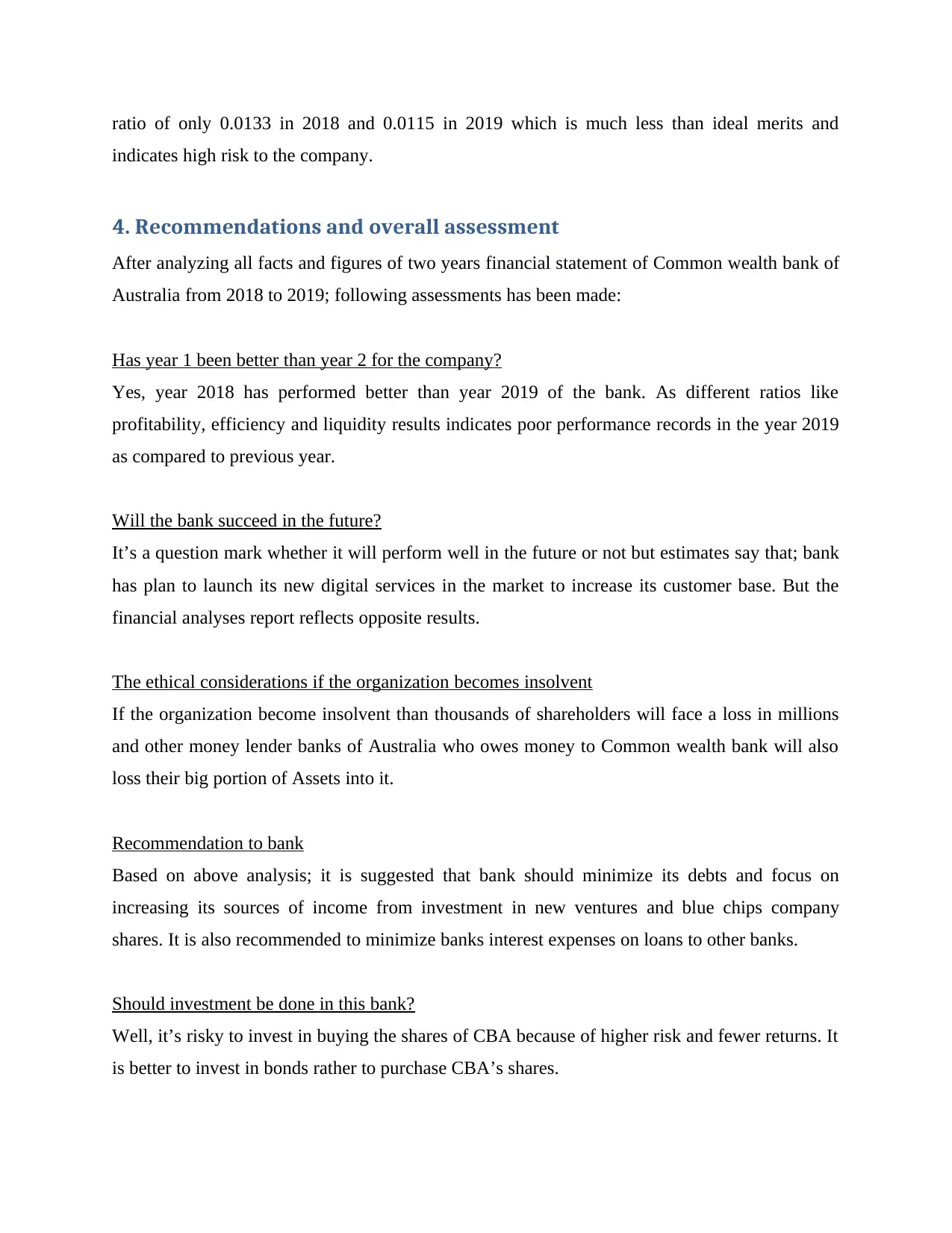
ratio of only 0.0133 in 2018 and 0.0115 in 2019 which is much less than ideal merits and
indicates high risk to the company.
4. Recommendations and overall assessment
After analyzing all facts and figures of two years financial statement of Common wealth bank of
Australia from 2018 to 2019; following assessments has been made:
Has year 1 been better than year 2 for the company?
Yes, year 2018 has performed better than year 2019 of the bank. As different ratios like
profitability, efficiency and liquidity results indicates poor performance records in the year 2019
as compared to previous year.
Will the bank succeed in the future?
It’s a question mark whether it will perform well in the future or not but estimates say that; bank
has plan to launch its new digital services in the market to increase its customer base. But the
financial analyses report reflects opposite results.
The ethical considerations if the organization becomes insolvent
If the organization become insolvent than thousands of shareholders will face a loss in millions
and other money lender banks of Australia who owes money to Common wealth bank will also
loss their big portion of Assets into it.
Recommendation to bank
Based on above analysis; it is suggested that bank should minimize its debts and focus on
increasing its sources of income from investment in new ventures and blue chips company
shares. It is also recommended to minimize banks interest expenses on loans to other banks.
Should investment be done in this bank?
Well, it’s risky to invest in buying the shares of CBA because of higher risk and fewer returns. It
is better to invest in bonds rather to purchase CBA’s shares.
indicates high risk to the company.
4. Recommendations and overall assessment
After analyzing all facts and figures of two years financial statement of Common wealth bank of
Australia from 2018 to 2019; following assessments has been made:
Has year 1 been better than year 2 for the company?
Yes, year 2018 has performed better than year 2019 of the bank. As different ratios like
profitability, efficiency and liquidity results indicates poor performance records in the year 2019
as compared to previous year.
Will the bank succeed in the future?
It’s a question mark whether it will perform well in the future or not but estimates say that; bank
has plan to launch its new digital services in the market to increase its customer base. But the
financial analyses report reflects opposite results.
The ethical considerations if the organization becomes insolvent
If the organization become insolvent than thousands of shareholders will face a loss in millions
and other money lender banks of Australia who owes money to Common wealth bank will also
loss their big portion of Assets into it.
Recommendation to bank
Based on above analysis; it is suggested that bank should minimize its debts and focus on
increasing its sources of income from investment in new ventures and blue chips company
shares. It is also recommended to minimize banks interest expenses on loans to other banks.
Should investment be done in this bank?
Well, it’s risky to invest in buying the shares of CBA because of higher risk and fewer returns. It
is better to invest in bonds rather to purchase CBA’s shares.
⊘ This is a preview!⊘
Do you want full access?
Subscribe today to unlock all pages.

Trusted by 1+ million students worldwide
1 out of 18
Related Documents
Your All-in-One AI-Powered Toolkit for Academic Success.
+13062052269
info@desklib.com
Available 24*7 on WhatsApp / Email
![[object Object]](/_next/static/media/star-bottom.7253800d.svg)
Unlock your academic potential
Copyright © 2020–2026 A2Z Services. All Rights Reserved. Developed and managed by ZUCOL.




